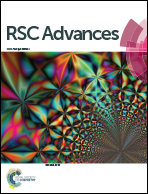Plasmonic Z-scheme α/β-Bi2O3–Ag–AgCl photocatalyst with enhanced visible-light photocatalytic performance†
Abstract
Environmental treatment over bismuth based catalysts due to their appropriate band structure and abundance is a promising process. However, the practical application of single-phase bismuth based catalysts is hindered by serious charge transport limitations. The plasmonic Z-scheme α/β-Bi2O3–Ag–AgCl photocatalysts resolving the drawbacks of single-component photocatalysts have been successfully synthesized by anchoring Ag–AgCl nanocrystals on the surfaces of α/β-Bi2O3 nanowire heterojunctions via the deposition–precipitation method assisted by the photo-reduction process. The as-prepared samples were characterized by a series of techniques, such as X-ray diffraction (XRD), electron microscopy (EM), Brunauer–Emmett–Teller analysis (BET), and UV-vis diffuse reflectance absorption spectra (UV-vis). The effects of the amount and the photo-reduction time of Ag–AgCl nanocrystals on the photocatalytic performance for the α/β-Bi2O3–Ag–AgCl composites were systematically investigated. Inspiringly, the plasmonic α/β-Bi2O3–Ag–10wt% AgCl–30 composites exhibit superior photocatalytic performance compared to α/β-Bi2O3 nanowires for the degradation of Rhodamine B and acid orange 7 dyes due to the effective charge transfer between Ag–AgCl nanocrystals and α/β-Bi2O3 nanowires. On the basis of photocatalytic activity and band structure analysis, a plasmonic Z-scheme photocatalytic mechanism is proposed; namely, two-step visible-light absorption is caused by the localized surface plasmon resonance of metallic Ag nanocrystals and the band gap photoexcitation of α/β-Bi2O3. This work could provide new insights into the fabrication of plasmonic Z-scheme photocatalysts with high performance and facilitate their practical application in environmental remediation issues.


 Please wait while we load your content...
Please wait while we load your content...